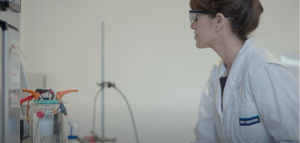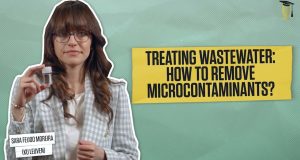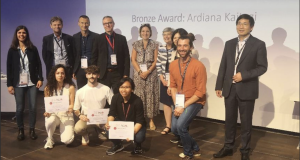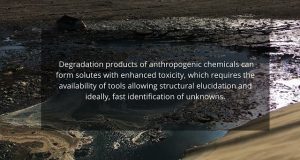
“From a very early age, we learn that water is the most important element for life, both for humans and for the other living beings that accompany us on the planet. It is even curious that 70% of the Earth and 70% of our body is water. The supply of clean and abundant water is so essential in all areas of our daily lives that it is recognized by the United Nations as a human right, fundamental to the health, dignity and prosperity of all. Yet today billions of people still live without access to sufficient and safe water resources, including not only the water needed for sanitation and hygiene, but also drinking water. According to 2020 figures, 1 in 3 people worldwide lacked water and soap at home, making them especially vulnerable to the spread of diseases such as the COVID-19 virus.
In addition to scarcity, we encounter other equally relevant problems in water, such as the presence of micropollutants in wastewater, for instance pharmaceuticals, antibiotics, cosmetics, chemicals, pesticides… Although we are referring to trace levels of synthetic organic substances released by human activities, whether from the industry or domestic consumption, many of these compounds are highly recalcitrant and cannot be completely eliminated in conventional wastewater treatment plants. Consequently, these compounds end up in treated effluents and, although in low concentrations, can cause toxicological effects on the environment and human health, as well as aggravate the problem of clean water scarcity.
Now you may ask… and what can be done about it? Fortunately, researchers around the world have been working for years to develop new water treatment technologies. Research in this field encompasses a large number of different treatments, some of which have already been brought to industrial scale. Among the most pioneering processes are advanced oxidation processes. These are based on the formation of radicals, which are highly reactive species that can degrade these micropollutants. These processes can be based on chemical agents (such as ozone or hydrogen peroxide), the application of ultraviolet light, catalytic processes (such as the Fenton process), electrochemical systems or a combination of any of the above.
In my PhD at KU Leuven in Belgium, we have been researching the improvement of electrochemical treatments, as they are not only efficient and safe, but also sustainable, since the electricity needed to carry out the process can come from renewable energies. In our research, we also seek to minimize the addition of chemicals, thus reducing the environmental and economic impact that these processes can present on a larger scale. From the field of chemical engineering, we seek to optimize the process conditions under these premises and propose new operation models. This work is part of the Marie Curie project under the name InnovEOX (Innovative Electrochemical Oxidation). This international program is formed by 6 universities and 11 companies from 7 different countries. Its objective is to achieve an innovative and interdisciplinary technological development, where the optimization of electrochemical oxidation processes goes hand in hand with new analytical methods to improve the detection of micropollutants, as well as toxicity studies and life cycle assessment.
The equipment needed to carry out an electrochemical process on a laboratory scale is based on a main unit that we call “reactor”, which can have a volume as small as 20 mL, or larger, up to 1 L. In both cases, we need to have two electrodes that allow the flow of electricity, which we call “anode” and “cathode”, and which must be submerged in the wastewater to be treated. We also need a reference electrode, which allows us to control the process digitally with a potentiostat. By applying current, we initiate a redox reaction, that is, some compounds are oxidized and therefore lose electrons, while others are reduced and gain electrons. What we seek with advanced oxidation processes is to generate highly reactive chemical species at the anode that are capable of degrading micropollutants. An example of these species are hydroxyl radicals, known for their high oxidative power, which we form through the electrolysis of water. There are other types of radicals, such as sulfate radicals or chlorine radicals. At present, the results are promising, although the efficiency of the treatment varies depending on the operating conditions and the initial composition of the wastewater, which may contain secondary compounds that must be controlled in the process. Moreover, the aspects related to operating costs and infrastructure must be evaluated to ensure the techno-economic feasibility of the treatment.
Finally, it should be borne in mind that not all the responsibility for solving the micropollutant problem should lie with science and companies. As consumers, we must be more aware of the water we use, not only in terms of quantity, but also in terms of the compounds we emit. Responsible use is also a key element within everyone’s reach to be more respectful with our health and the environment.”

Sara is an enthusiastic Chemical Engineer with a passion for sustainability, innovation and design. She comes from a small and cosy city in the north-west side of Spain: Santiago de Compostela. Currently, Sara is an Marie Curie Early Stage Researcher (ESR) for the InnovEOX project at KU Leuven and under the supervision of Prof. Dr. Raf Dewil. In particular, she is ESR1 focusing on developing optimized process conditions for the in-situ generation of sulphate radicals and subsequent organic degradation of emerging contaminants in water.
 InnovEOX Innovative Electrochemical OXidation Processes for the Removal and Analysis of micro-pollutants in water streams
InnovEOX Innovative Electrochemical OXidation Processes for the Removal and Analysis of micro-pollutants in water streams



